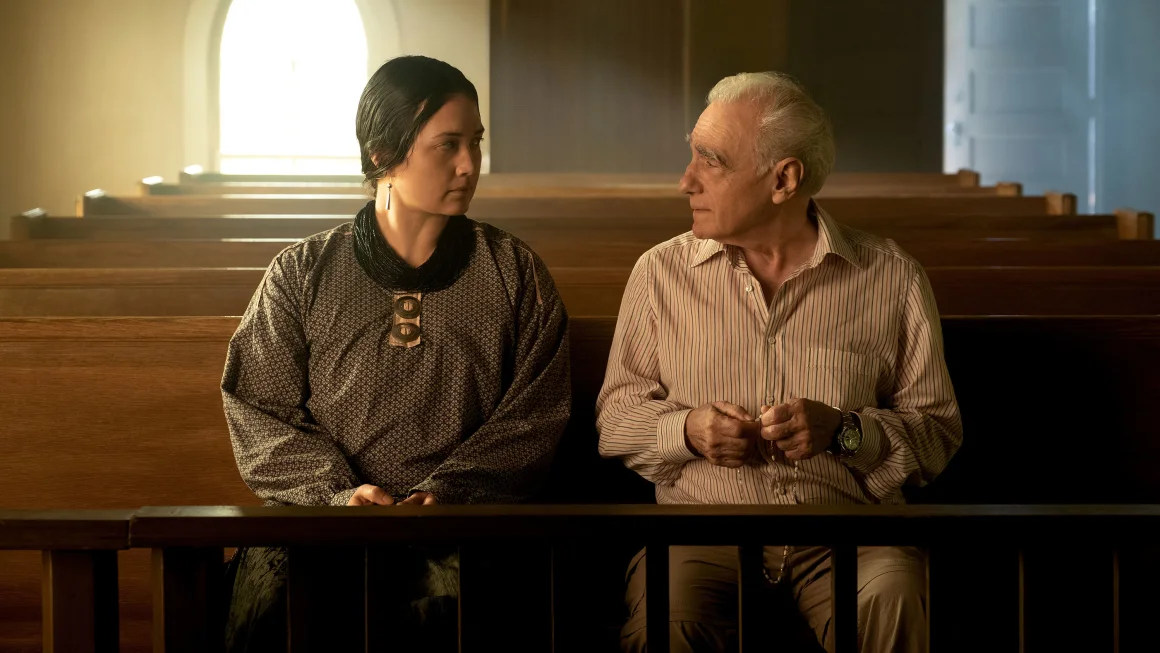“Painful, grueling, unrelenting and unnecessarily graphic:” In a thread posted by Devery Jacobs of “Reservation Dogs” fame on X, formerly known as Twitter, the Native American actress dug into what made “Killers of the Flower Moon,” the most recent film directed by Martin Scorsese, a “hellfire.”
In “Killers of the Flower Moon,” audiences witness the gradual unraveling of a Native American community in Oklahoma. The central character isn’t Native American; rather the movie takes the lens of the indecisive, yet obedient character of Ernest Burkhart (Leonardo DiCaprio).
Jacobs argued that there is a predominant issue among stories about Native people told by non-Natives in that “they center the white perspective and focus on Native people’s pain.”
Burkhart plots — alongside his uncle William King Hale ( Robert De Niro) — to murder Osage for their headrights, which entitle their owner to quarterly payments from the Osage Mineral Estate. These headrights cannot be bought or sold, only inherited. Their value motivates Burkhart and his co-conspirators to murder Osage despite his being married to Mollie Kyle, a significant member of the community.
It’s not “love” that he has with her when his secret is that he’s killing her whole family. As Christopher Cote, the film’s Osage language consultant, said during the Los Angeles premiere of the movie, “that’s not love — that’s just beyond abuse.” Intimacy between people in the movie is constantly portrayed with a sinister underbelly in order to accurately display the interpersonal dynamics between Natives and non-Natives.
Throughout the near four-hour runtime, the film depicts Burkhart’s brief guilt, anger, self-hatred, doubt, and lust for power and control. It spotlights the intimate moments of the abuser — his lone moments — but hardly depicts Mollie’s moments of solitude. As a result, Jacobs claimed that he doesn’t “feel that these very real people were shown honor or dignity in the horrific portrayal of their deaths.”
In “Killers of the Flower Moon,” I’m left to wonder what Mollie thought when no one was watching.
When we’re talking about such clearly defined histories where the source of destruction is very crystalline, there’s something odd about representing the “loneliness” of Burkhart but not the loneliness of the victims at hand.
In “Killers of the Flower Moon,” I’m left to wonder what Mollie thought when no one was watching. Where is her “loneliness” and her reckoning with the destruction? What would have fixed this “something missing” would be to show quieter moments with Mollie. Specifically, showing her unresolved emotions with Burkhart and the anger she must have felt after realizing Burkart’s actions may have fixed this “something missing.”
Mollie’s loneliness, however, is difficult to express. What other person out there besides her own can relate to her experience? The relief of sharing these feelings of pain and anger never comes because a true resolution is not reached. Courtroom fights and legal justice is reached, yet systemic disadvantages continue and alienation persists. You can’t simply forget it, especially if the reasons for why it happened — collective bystanderism to human horrors and condonement of genocidal governmental policy — persist.
Typically in narrative, internal conflicts can be resolved with interaction with other characters and a relief of emotional burden. Mollie can’t interact and receive this relief of her emotional burden. To Mollie’s situation, it’s difficult for a writer — let alone a non-native — giving this character emotional relief, a third act resolution, due to the breadth of complexities within her trauma caused by oppression.
The final scene of the film makes it clear that Scorsese is self-aware that this whole four-hour movie is a top-down observation. It’s a self-corrective admission to the audience that this isn’t the full picture. The “something missing” is not an incidental flaw, rather a purposeful mechanism.
Perhaps the movie’s silence on Mollie’s perspective and her intimate moments respects the complexity of this loneliness of the marginalized. This “something missing” is something white America doesn’t deserve to see. The death of those wide and beautiful spectra of emotions is too grand for the screen, radio shows and culture of, as the Osage in the movie put it, the “white man.” Its exclusion is a reverence of its beauty.

